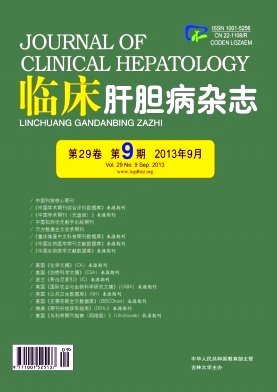|
[1]LIU XY, CHEN J, WANG XX, et al.Etiological analysis of 3233patients with acute liver failure, subacute liver failure and acuteon-chronic liver failure[J].Clin Med Engineering, 2012, 19 (5) :823-825. (in Chinese) 刘晓燕, 陈婧, 王晓霞, 等.3233例急性、亚急性、慢加急性肝衰竭病因特点分析[J].临床医学工程, 2012, 19 (5) :823-825.
|
|
[2]LUCENA MI, ANDRADE RJ, KAPLOWITZ N, et al.Phenotypic characterization of idiosyncratic drug-induced liver injury:the influence of age and sex[J].Hepatology, 2009, 49 (6) :2001-2009.
|
|
[3]FERRAJOLO C, CAPUANO A, VERHAMME KM, et al.Druginduced hepatic injury in children:a case/non-case study of suspected adverse drug reactions in VigiBase[J].Br J Clin Pharmacol, 2010, 70 (5) :721-728.
|
|
[4]KUNST H, KHAN KS.Age-related risk of hepatotoxicity in the treatment of latent tuberculosis infection:a systematic review[J].Int J Tuberc Lung Dis, 2010, 14 (11) :1374-1381.
|
|
[5]KAPLOWITZ N, DELEVE LD.Drug-induced liver disease[M], 2nd edn, Informa, New York, 2007.
|
|
[6]CHALASANI N, BJORNSSON E.Risk factors for idiosyncratic drug-induced liver injury[J].Gastroenterology, 2010, 138 (7) :2246-2259.
|
|
[7]LAMMERT C, EINARSSON S, SAHA C, et al.Relationship between daily dose of oral medications and idiosyncraticdrug-induced liver injury:search for signals[J].Hepatology, 2008, 47 (6) :2003-2009.
|
|
[8]LAMMERT C, BJORNSSON E, NIKLASSON A, et al.Oral medications with significant hepatic metabolism at higher risk for hepatic adverse events[J].Hepatology, 2010, 51 (2) :615-620.
|
|
[9]DALY AK, DONALDSON PT, BHATNAGAR P, et al.HLA-B*5701genotype is a major determinant of drug-induced liver injury due to flucloxacillin[J].Nat Genet, 2009, 41 (7) :816-819.
|
|
[10]YUAN J, GUO S, HALL D, et al.Toxicogenomics of nevirapineassociated cutaneous and hepatic adverse events among populations of African, Asian, and European descent[J].AIDS, 2011, 25 (10) :1271-1280.
|
|
[11]DONALDSON PT, DALY AK, HENDERSON J, et al.Human leucocyte antigen class II genotype in susceptibility and resistance to co-amoxiclav-induced liver injury[J].J Hepatol, 2010, 53 (6) :1049-1053.
|
|
[12]LUCENA MI, MOLOKHIA M, SHEN Y, et al.Susceptibility to amoxicillin-clavulanateinduced liver injury is influenced by multiple HLA class I and II alleles[J].Gastroenterology, 2011, 141 (1) :338-347.
|
|
[13]SINGER JB, LEWITZKY S, LEROY E, et al.A genome-wide study identifies HLA alleles associated with lumiracoxib-related liver injury[J].Nat Genet, 2010, 42 (8) :711-714.
|
|
[14]McCORMACK M, ALFIREVIC A, BOURGEOIS S, et al.HLA-A*3101 and carbamazepineinduced hypersensitivity reactions in Europeans[J].N Engl J Med, 2011, 364 (12) :1134-1143.
|
|
[15]URBAN T, SHEN YF, CHALASANI NP, et al.A genome-wide association study identifies potential susceptibility loci for hepatotoxicity due to various drugs[J].Gastroenterology, 2011, 140 (Suppl1) :S886-S886.
|
|
[16]LEE SW, CHUNG LS, HUANG HH, et al.NAT2 and CYP2E1 polymorphisms and susceptibility to first-line anti-tuberculosis drug-induced hepatitis[J].Int J Tuberc Lung Dis, 2010, 14 (5) :622-626.
|
|
[17]LYU X, TANG S, XIA Y, et al.NAT2 genetic polymorphisms and anti-tuberculosis drug-induced hepatotoxicity in Chinese community population[J].Ann Hepatol, 2012, 11 (5) :700-707.
|
|
[18]DALY AK, DAY CP.Genetic association studies in drug-induced liver injury[J].Drug Metab Rev, 2012, 44 (1) :116-126.
|
|
[19]DENG R, YANG T, WANG Y, et al.CYP2E1 RsaI/PstI polymorphism and risk of anti-tuberculosis drug-induced liver injury:a meta-analysis[J].Int J Tuberc Lung Dis, 2012, 16 (12) :1574-1581.
|
|
[20]CAI Y, YI J, ZHOU C, et al.Pharmacogenetic study of drug-metabolising enzyme polymorphisms on the risk of anti-tuberculosis drug-induced liver injury:a meta-analysis[J].PLoS One, 2012, 7 (10) :e47769.
|
|
[21]TANG N, DENG R, WANG Y, et al.GSTM1 and GSTT1 null polymorphisms and susceptibility to anti-tuberculosis drug-induced liver injury:a meta-analysis[J].Int J Tuberc Lung Dis, 2013, 17 (1) :17-25.
|
|
[22]LANG C, MEIER Y, STIEGER B, et al.Mutations and polymorphisms in the bile salt export pump and the multidrug resistance protein 3 associated with drug-induced liver injury[J].Pharmacogenet Genomics, 2007, 17 (1) :47-60.
|
|
[23]URBAN TJ, SHEN Y, STOLZ A, et al.Limited contribution of common genetic variants to risk for liver injury due to a variety of drugs[J].Pharmacogenet Genomics, 2012, 22 (11) :784-795.
|
|
[24]ANDRADE RJ, LUCENA MI, KAPLOWITZ N, et al.Outcome of acute idiosyncratic drug-induced liver injury:Long-term follow-up in a hepatotoxicity registry[J].Hepatology, 2006, 44 (6) :1581-1588.
|
|
[25]BORRAZ Y, FERNNDEZ MC, GARCA-MUOZ B, et al.Would it be desirable to modify the cut-off point for definition of chronicity in drug-induced liver injury (DILI) ?[J].Hepatology, 2010, 52 (Suppl S1) :457a.
|
|
[26]ROCHON J, PROTIVA P, SEEFF LB, et al.Reliability of the Roussel Uclaf Causality Assessment Method for assessing causality in drug-induced liver injury[J].Hepatology, 2008, 48 (4) :1175-1183.
|
|
[27]DAI WJ, LAI RT, WANG H, et al.The analysis of clinical features and risk factors in 113 patients with drug-induced liver injury[J].J Clin Hepatol, 2012, 28 (10) :1058-1065. (in Chinese) 戴维佳, 赖荣陶, 王晖, 等.113例药物性肝损害临床特征及影响因素分析[J].临床肝胆病杂志, 2012, 28 (10) :1058-1065.
|
|
[28]WATANABE M, SHIBUYA A.Validity study of a new diagnostic scale for drug-induced liver injury in Japan-comparison with two previous scales[J].Hepatol Res, 2004, 30 (3) :148-154.
|
|
[29]WATKINS PB.Biomarkers for the diagnosis and management of drug-induced liver injury[J].Semin Liver Dis, 2009, 29 (4) :393-399.
|
|
[30]ROCKEY DC, SEEFF LB, ROCHON J, et al.For the Drug-Induced Liver Injury Network:A structured assessment process to assign causality in drug induced liver injury[J].Hepatology, 2010, 51 (6) :2117-2126.
|
|
[31]TAJIRI K, SHIMIZU Y.Practical guidelines for diagnosis and early management of drug-induced liver injury[J].World J Gastroenterol, 2008, 14 (44) :6774-6785.
|
|
[32]BJRNSSON E, OLSSON R.Outcome and Prognostic Markers in Severe Drug-Induced Liver Disease[J].Hepatology, 2005, 42 (2) :481-489.
|
|
[33] U.S.Department of Health and Human Services, Food and Drug Administration, Center for Drug Evaluation and Research, Center for Biologics Evaluation and Research.Guidance for Industry Drug-Induced Liver Injury:Premarketing Clinical Evaluation.http://www.fda.gov/BiologicsBloodVaccines/GuidanceComplianceRegulatoryInformation/Guidances/default.htm.
|







 DownLoad:
DownLoad: